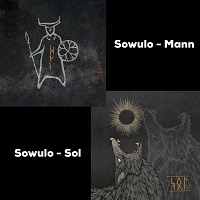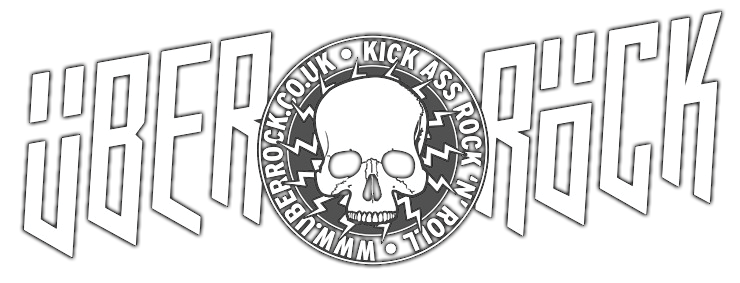By Bona Pjarren
 Sowulo are a Dutch dark folk band that makes modern day Viking music. Their ritual music is designed to take you on an inner journey. It’s all built upon the rune ‘Sowulo’, which represents the sun. According to his bio, Sowulo founder Faber Horbach intentionally invokes his inner warrior, lover, king and magician, and hopes it will help you to do the same. This double album is all about growing into a mature human being by connecting with the power of the four archetypes, and consciously walking together with them on the adventure we call the wheel of life. These compositions express his interpretation of the four archetypes which he connects to the four seasons within and without, and so they follow the cyclical nature of ‘Mann’ (I would also like to point out that ‘Mann’ is derived from the ancient Germanic word which translates as humans and is not gender specific).
Sowulo are a Dutch dark folk band that makes modern day Viking music. Their ritual music is designed to take you on an inner journey. It’s all built upon the rune ‘Sowulo’, which represents the sun. According to his bio, Sowulo founder Faber Horbach intentionally invokes his inner warrior, lover, king and magician, and hopes it will help you to do the same. This double album is all about growing into a mature human being by connecting with the power of the four archetypes, and consciously walking together with them on the adventure we call the wheel of life. These compositions express his interpretation of the four archetypes which he connects to the four seasons within and without, and so they follow the cyclical nature of ‘Mann’ (I would also like to point out that ‘Mann’ is derived from the ancient Germanic word which translates as humans and is not gender specific).
‘Mann’/’Sol’ actually represents the re-release of two albums: ‘Mann’ was originally released August 2019 and ‘Sol’ in 2016, with both now being reworked on vinyl.
‘Gastcyning’ I think means “guest king” and is the first track on ‘Mann’. Combining harp and cello with stunning vocal arrangements, ‘Gastcyning’ is a strong introductory piece. ‘Wulfwiga’, or ‘Wolf Heart’ translated from the old English, is a powerful track with chants delivered in the style of throat singing as it powers forward hypnotically with tribal beats. ‘Heahlufu’ is old Norse for “high love” and has a ballad feel to its execution. Again, the strong, distinctive percussion helps to give this song some punch.
‘Sceadugenga’ means “shadow goer”: Grendel from ‘Beowulf’ is a sceadugenga. Fittingly, it starts with throat singing before going into a vocal harmony drone. ‘Sceadugenga’ has a medieval charm about it with a brooding style. From the Anglo-Saxon, ‘Brego in Breoste’ means something like “king in chest”. The song has a soaring quality to it, dipping and flying it weaves its magic with more throat singing and vocal harmonies. It was also released as a single. ‘Swīnhæleðas’ means “boar’s snout” and presumably refers to the Norse battle strategy of forming a wedge. It does have a militaristic feeling to it but also has lulls that draw me into the song. There is an ebb and flow that takes me on a journey.
‘Faegru Fara’ means “beautiful travel companion” and has an otherworldly charm to it. With lilting interludes and dance like passages, it delivers a timeless quality to its construction. ‘Slincan Snican’ is Old English for serpent. With an ominous sample and intertwining strings this is a purely descriptive song about snakes. It also features some nice vocals with an almost trance like quality. ‘Innra Aecer’, or ‘Inner Field’, is a raucous piece with pounding drums and chant type vocals. It features some interesting break downs. Lyrically it seems to be about blood sacrifice to promote a good harvest.
‘Beraboarn’ means “bear fighter” and is a song about a berserker. Again, it has very energetic drumming before dropping into something more contemplative. There are some nice ambient string washes before it picks up the tempo again into something more militaristic. ‘Deoplicu Thearf’, or ‘Deep Desire’, follows the pattern of minimalistic lyrics which make for more of a chant than a song. It does give a more meditative quality to this work. Lilting and delicate strings interweave with vocals floated above. The closing track’s title, ‘Wohs Wildum’, means “wild animal”, and it is a chant. The full lyric is “grew on a wild animal”. It is a rather pleasant slow dance track.
So that is the end of the first album entitled ‘Mann’. It is a pleasant work with plenty of Norse/Celtic style neo-folk elements.
Now let’s start with ‘Sol’ which is an acoustic album and seems to revolve predominately around pagan festivals of the year. As it comprises of tracks that are quite similar in nature from a construction point of view, I have decided to concentrate mainly on the lore and meaning of the tracks rather than give a technical breakdown of each track.
The album commences with ‘Noodlot Proloog’ or ‘Fate Prologue’, which is a purely instrumental track with dance elements. ‘Ginnungagap’ is the first “proper” song. Ginnungagap is the void in which the world was created, according to Norse law. It’s a brooding track with dark vocals. ‘Skoll’ is a wolf that chases the moon across the sky and is another dance-orientated track.
‘Beltane’ refers to the festival held in May when bonfires are lit, otherwise known as Bale Fires. ‘Ostara’ is the pagan festival derived from the Anglo-Saxon Eostra goddess associated with the hare and eggs… hence the Easter bunny and eggs. ‘Dageraad’ is from the Dutch as far as I can ascertain and means dawn or the very beginning of the day.
‘Imbolc’ is the pagan festival that marks the halfway point between winter solstice and the spring equinox. For me it is associated with Nertus and the cycle of death, but, more importantly, rebirth. ‘Yule’ is well known but misunderstood. People often associate it with 12 days. The 12 days was a concept brought in by industrial factory owners to limit the amount of time their workers had off. In ancient reality, it did start around the 21st of December with Mother’s Night, when gifts were traditionally exchanged, but the feasting lasted as long as the perishable food stocks lasted. It was also a time for crafting in all its many forms.
‘Sol’ literally means sun and feels like a progression from ‘Yule’ as Yule is also a festival heralding the rebirth of the sun god Baldr. ‘Mabon’ celebrates the Autumnal equinox. It is essentially harvest festival and is associated with the early Celtic god Maponos a god of youth. ‘Lammas’ is a festival falling on the 1st of August, derived from the Anglo-Saxon it means loaf day. ‘Arvakr’ means “early awake” and is one of the horses that draws the chariot of the sun across the sky; it comes from the old Norse tradition. ‘Alsviðr’ is the companion horse from the same tale, which is covered in the final track of the album.
I get the feeling that ‘Sol’ is a concept album that celebrates the travels of the sun as it transitions through the year drawn by Alsviðr and Arvakr. While at first sight it may seem a bit of a mix of traditions; but, if you think about it, the Germanic tribes which were later to be popularised as Norse, Vikings and Anglo-Saxons would originally be referred to by the classical writers as Celts, and with this in mind I feel the album holds together as a cohesive whole.
Taking both albums into account they are beautifully played and well-conceived, but I feel they were never meant to be listened to back to back. Taking into account the limited palate of almost exclusively acoustic instruments, this review did feel a bit of a marathon and some tracks did blend into one another. The best way to appreciate them is one at a time, as I did find it hard work reviewing one track after another stretching over the two albums. ‘Sol’ would be a good choice of album for any Pagan to dip into for celebrating their festivals, particularly choosing an appropriate track depending on the celebration. Enjoying individual tracks would be, for me, more enjoyable than trying to listen to it as a whole. However, if you are new to Sowulo, or do not already own these two albums, then the package is worth the purchase.
- ‘Mann’/’Sol’ is released today (Friday 25 February). You can get your copy HERE.
- All content © Über Rock. Not to be reproduced in part or in whole without the express written permission of Über Rock.
